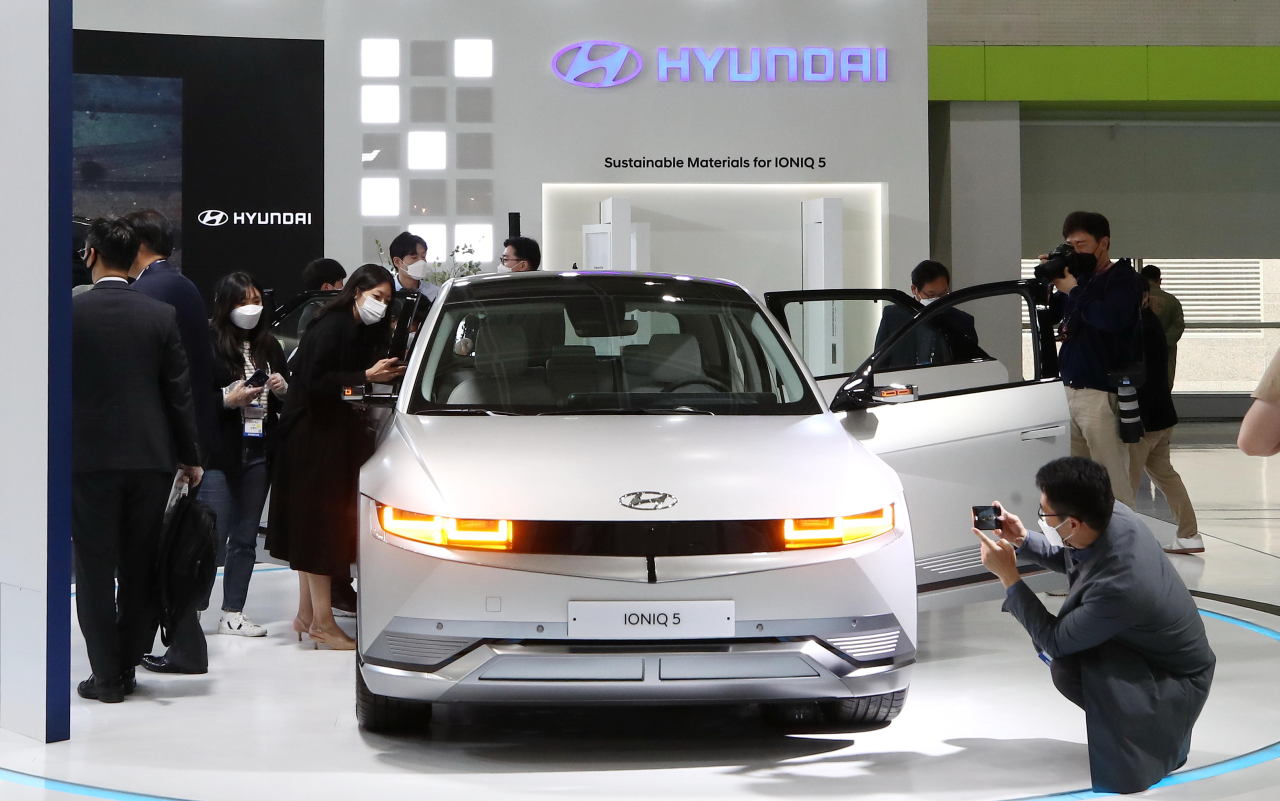Hyundai struggles to expedite Ioniq 5 production
Automaker suggests ‘removal of options’ for impatient customers
By Bae HyunjungPublished : May 19, 2021 - 15:29

Pressed by the prolonged semiconductor shortage and the rapidly diminishing state subsidy balance, South Korea’s top automaker Hyundai Motor is pushing to expedite the release of its new all-electric vehicle Ioniq 5 at all costs.
The automaker, which had earlier underlined passenger comfort and various safety functions of the new model, is now suggesting that purchasers compromise some of these options in order to speed up their order.
“We are considering various scenarios for customers who are expected to receive their cars later than expected,” said a spokesperson from the company.
The automaker has recently been contacting customers waiting for the Ioniq 5, persuading them to rule out some of the advanced options -- such as the parking assist and digital side mirrors -- for the sake of faster production and delivery. Those who agree to the changes will be offered a special price discount, according to officials.
Since launching the Ioniq 5 on Feb. 25, Hyundai Motor has received about 43,000 preorders, but only about 200 have been delivered so far, as of the second week of May, industry data showed.
The carmaker’s sister brand Kia has also prematurely closed advance orders for the EV6, its all-electric sport utility vehicle, after receiving 21,000 orders.
Hyundai Motor debuted the Ioniq 5 and the imbedded Electric-Global Modular Platform -- Hyundai Motor Group’s exclusive EV operating system -- this year in an ambitious move to vie with global EV champion Tesla.
The company, however, soon faced three roadblocks: the shortage of semiconductors and other key parts, the rapidly decreasing state subsidy budget for EV purchases, and the labor union’s backlash against the company’s planned investment in the United States.
Hyundai Motor’s initial target timeline was to build 10,000 units of the Ioniq 5 last month, as to gain an upper hand in the fast expanding EV market and to provide customers the opportunity to receive state subsidies in time.
The first snag was the week-long operation suspension of its Ulsan plant in early April, due to the lack of traction motors. The halt came at a time when automakers were on the brink of stopping their production lines amid the global shortage of automotive chips.
While the supply issue affected all carmakers and most IT giants, battery-powered vehicles received the hardest blow as they require a higher number of chips than conventional internal combustion engine cars.
The stalled production timeline of the new EV has been raising concerns among aspiring car buyers here, especially as the state subsidy balance has recently been reported to be swiftly running out.
In spite of the government’s hurried action to allocate more budget and to alleviate the subsidy payment process, some customers are looking to turn to alternative choices currently available -- including Tesla’s Model Y which has recently rounded off its first-batch delivery.
The application reception for all-electric car subsidies in Seoul came to 81.5 percent of the yearly budget total as of end-April and has likely exceeded the 90 percent mark as of the second week of May, according to data from the Korea Automobile Manufacturers Association.
This latest figure is deja vu from last year, when the capital city saw its regional budget for EV subsidy drain out in late September, leaving no financial resources for EV purchasers at the end of the year.
As the subsidy allocated per car is made up from the central government’s budget and the local government’s budget, the exhaustion takes place at a faster pace in the metropolitan region -- where demand is higher and the related infrastructure is well established.
Once the local government’s subsidy runs out prematurely, EV customers in the corresponding region may only access the central government’s subsidy.
Under revised rules starting this year, vehicles priced below 60 million won ($53,144) are eligible for 100 percent of the subsidies, while those priced between 60 million won and 90 million won may receive half the ceiling. Premium models priced over 90 million won are excluded from the subsidy program.
The maximum subsidy from the central government is 8 million won ($7,086) for each buyer, while the corresponding provincial government may offer up to 11 million each.
By Bae Hyun-jung (tellme@heraldcorp.com)



![[AtoZ into Korean mind] Humor in Korea: Navigating the line between what's funny and not](http://res.heraldm.com/phpwas/restmb_idxmake.php?idx=644&simg=/content/image/2024/04/22/20240422050642_0.jpg&u=)

![[Exclusive] Korean military set to ban iPhones over 'security' concerns](http://res.heraldm.com/phpwas/restmb_idxmake.php?idx=644&simg=/content/image/2024/04/23/20240423050599_0.jpg&u=20240423183955)

![[Herald Interview] Why Toss invited hackers to penetrate its system](http://res.heraldm.com/phpwas/restmb_idxmake.php?idx=644&simg=/content/image/2024/04/22/20240422050569_0.jpg&u=20240422150649)
![[Graphic News] 77% of young Koreans still financially dependent](http://res.heraldm.com/phpwas/restmb_idxmake.php?idx=644&simg=/content/image/2024/04/22/20240422050762_0.gif&u=)






![[Exclusive] Korean military to ban iPhones over security issues](http://res.heraldm.com/phpwas/restmb_idxmake.php?idx=652&simg=/content/image/2024/04/23/20240423050599_0.jpg&u=20240423183955)



![[Today’s K-pop] Ateez confirms US tour details](http://res.heraldm.com/phpwas/restmb_idxmake.php?idx=642&simg=/content/image/2024/04/23/20240423050700_0.jpg&u=)